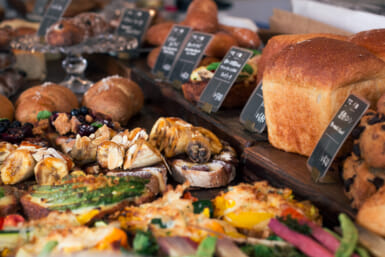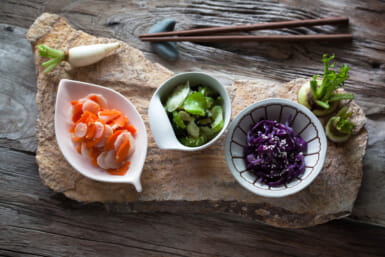with Elizabeth Andoh
The Right Way to Cook Sukiyaki at Home—& More
ONE-POT COOKING (NABEMONO)
With the chilly weather here and an abundance of fall vegetables, nubemono (one-pot cookery) is just the thing.
It’s great family fun, or easy entertaining. Although suki-yaki is probably the best known of these dishes, mizutaki is an equally satisfying and less expensive approach.
Recipes for both follow:
SUKIYAKI
ingredients:
- 400-500 grams beef, thin sliced beef suet
- 1/2 hakusai, cut into smaller wedges
- 1 bunch shungiku, washed and trimmed
- 1 package shiitake (fresh), rinsed, patted dry and with stems removed
- 3-4 naganegi (white part only), cut into 1-inch pieces
- 1 cake of yaki-dofu, drained and cut into 1-inch cubes
- 1 clump shirataki, rinsed, drained and cut in half
seasonings:
- 1/2 cup shoyu (regular soy sauce)
- 1/4 cup sake (or white wine)
- 1/2 cup dashi
- 1/4 cup sugar
- fresh eggs (for dipping)— optional
equipment:
heavy skillet (preferably wrought iron) and cooking unit for at-table cooking
instructions:
1. Decoratively arrange the beef, vegetables and other ingredients on a large platter.
2. Place the seasonings in separate bowls or pitchers and bring them to the table, too.
3. Preheat the skillet, then add the suet and let it melt, rubbing all the surfaces with the melted fat.
4. Put 1/2 the beef, then half the naganegi into the skillet and cook them, without stirring for 1-2 minutes.
5. Push the beef and naganegi aside, add some hakusai wedges and a few shiitake and season all with about 1 tablespoon each sugar and shoyu. Add a splash of sake, turn down the heat to medium and let things cook for another 2-3 minutes. Start eating from those pieces which are cooked thru. A dip, made by beating a raw egg until frothy, is optional for each person.
6. Add more meat and vegetables to the pan and season again. If the liquid seems too scant, add some dashi. There should never be so much liquid, though, that the ingredients are submerged.
7. Shirataki and yaki-dofu absorb the juices from meat and vegetables and are best towards the end. Shungiku cooks very quickly and should be added to the skillet just for a few moments.
8. Replenish after eating until all the ingredients have been used.
notes:
1. Hakusai is translated most often as “Chinese cabbage”; sometimes as “celery cabbage.” Its available at any market.
2. Naganegi are leeks, shungiku are chrysanthemum loaves and shiitake are black mushrooms.
3. Shirataki are those gelatinous looking transparent “noodles” that don’t melt with heat. They are made from a tuber vegetable and sold at vegetable stores and meat counters, too.
4. Yaki-dofu is grilled tofu (“bean curd”).
* * *
MIZUTAKI
ingredients:
- 400-450 grams chicken fillet or thin sliced pork, cut into bite-sized pieces
- 3-4 naganegi (leek), cut into 1-inch lengths
- 1 package shimejitake
- 1/2 wedge hakusai
- 1 bunch shungiku or komatsuna
- 1 clump shirataki, rinsed, drained and cut in 3
- 1 stick gobo
- broth: 4 cups dashi
- lemon wedges
- soy sauce
equipment:
large, open-mouthed pot, with lid, preferably of glazed clay —cooking unit for at-table cooking
instructions:
1. Rinse the shimejitake in luke warm water and cut into smaller pieces. Wash, pat dry and trim the shungiku or komatsuna. Peel the gobo and slice it in thin slivers. Soak the slivers in cold water for 10 minutes before draining them.
2. Arrange the vegetables and chicken or pork decoratively on a large platter.
3. Bring the broth to a simmer and add the meat and naganegi. Cook for a few minutes before adding some of the other ingredients.
4. Eat those morsels which cook first, replenishing with remaining ingredients. Continue to eat (dipping in a sauce of part soy sauce, part lemon juice), replenish, eat replenish, etc. until all the ingredients have been used. The final broth makes a fine soup for drinking, by the way.
5. Shimejitake and shungiku cook very quickly, hakusai takes slightly longer (though too much cooking makes it soggy and tasteless, gobo still longer.
notes:
1. Shimejitake are a kind of fungi (mushroom), pearly grey in color. They are a fall and winter specalty.
2. Gobo is burdock root and is available throughout most of the year.
3. Komatsuna is a collard green-like vegetable.








